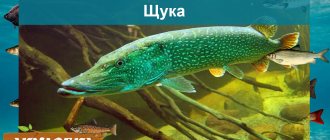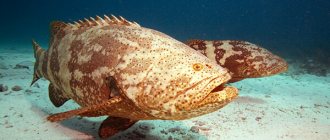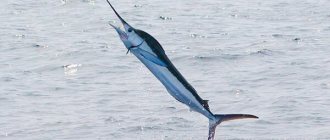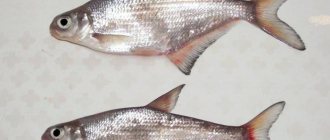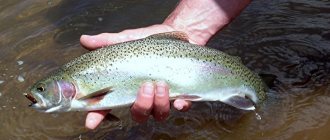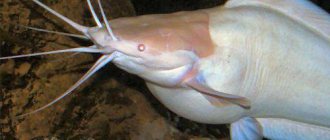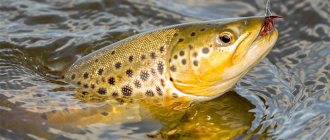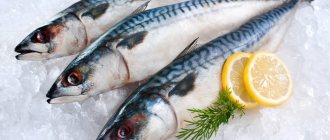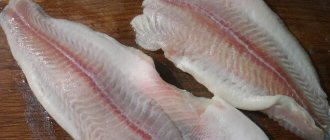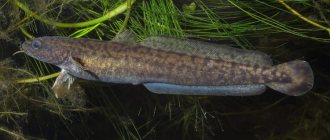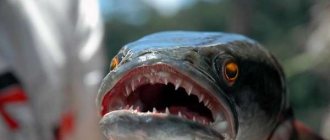- Wild animals
- >>
- Fish
Trout is a lake or more often anadromous fish belonging to the salmon family. Most often it is confused with trout due to its similar appearance and lifestyle. A distinctive feature of the species is the ability to quickly adapt to various living conditions. The lake form can quickly transition to an anadromous, marine form, if necessary. The object of active fishing is also grown in artificial reservoirs.
Origin of the species and description
Photo: Kumzha
Trout are divided into freshwater and sea-living. By the way, for convenience, freshwater is often simply called trout. Both of these species belong to salmonids and have such obvious differences that it is very difficult to classify them as one species.
To study the distribution pathways of brown trout, scientists use mitochondrial DNA. Thanks to him, it was possible to establish that the main distribution of brown trout is observed from Norway. In the White and Barents Seas, no significant differences were found between representatives of this species, which allows us to conclude that brown trout can be classified as one family, regardless of habitat.
Video: Brown trout
Interesting fact: Previously, there was an opinion that brown trout is a relative of salmon. But then ichthyologists, after conducting a thorough analysis of the structure of the fish, came to the conclusion that salmon is a modified flow of migratory brown trout.
It is believed that migratory brown trout fatten up in the sea, after which they go to river basins to spawn, where they mature. But freshwater individuals, which feed there before spawning, are often called trout. Among freshwater fish there are most males, but among migratory fish there are most females. During the spawning period, they all unite with each other, forming a large general population.
Interesting fact: Many people believe that brown trout is a slightly modified trout. At one time, trout was brought to New Zealand, which gradually rolled into rivers and the sea. Thus, it gradually turned into a migratory brown trout.
Recipes
Fish meat comes in both white and red. It all depends on the habitat and living conditions. Therefore, trout can be prepared in various ways. Let's look at the fastest and most popular ones.
Trout with broccoli
You will need:
- fish - depending on the number of people;
- 400 g broccoli;
- cheese;
- salt pepper.
Preparation:
Clean and divide the carcass into portions, pour lemon juice on both sides. Leave for half an hour, then bake at 140 degrees for 40 minutes. Simmer broccoli in water and olive oil for up to 7 minutes. Grate the cheese on a coarse grater. Cover the fish with broccoli and sprinkle with cheese, then place in the oven for 5 minutes.
Fish with vegetables
You will need:
- 2.5 kg sea trout;
- tomatoes – 1 kg;
- celery and leek - 3 stalks;
- butter, lemon juice and herbs - to taste.
Cooking method:
Divide the meat into portions, cut the vegetables into rings. Distribute the ingredients evenly on the baking sheet. Salt and pepper at the owner's discretion. Make a sauce from lemon juice and butter. Pour over the fish and place in the oven at 140 degrees for 40–60 minutes.
Recommended to be served with a side dish.
Trout with rice, raisins and potatoes
You will need:
- Half a kilo of potatoes;
- Raisins (1 spoon is enough);
- Salt and pepper - to taste;
- Rice – 200 g;
- Orange – 1 piece;
- Onions – 2 pcs;
- Trout fillet – 1 pc.
To learn more:
Char: description of red fish
Cooking method:
Finely chop the potatoes and simmer until half cooked with a small amount of water. Rinse the rice in cold water and cook. Cut the orange into slices. Fry the trout fillet on each side for no more than 3 minutes. After cooking, remove the fillet to a warm place. Cut the onion into rings and fry in brown trout oil, add potatoes and orange peels. Add raisins to rice and mix thoroughly. After this, mix the ingredients in a plate in equal portions.
Appearance and features
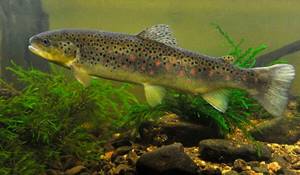
Photo: What does brown trout look like?
The body of the brown trout is covered with very dense scales and has an elongated shape. The mouth is very large and has a slanted outline. The upper jaw is clearly elongated and extends beyond the line of the edge of the eye. The jaws of adult males can arch strongly. But this is less noticeable than with salmon.
Black spots (very large) cover the entire body of the fish. Below the lateral line they become round in shape and noticeably smaller. Juveniles have a color identical to trout. When the fish is in fresh water, it has a silvery color. When the fish reaches sexual maturity, small pink spots appear on the sides. This is especially noticeable in males.
The average brown trout has a length from 30 to 70 cm, and a weight from 1 to 5 kg. But in the Baltic Sea you can also find much larger forms (more than 1 m in length and more than 12 kg in weight). Very often this species is compared to salmon. Indeed, they have a lot in common.
But it is still customary to identify a number of parameters that will allow you to easily distinguish brown trout:
- Brown trout have much smaller scales on their tail;
- Brown trout also have much fewer gill rakers;
- the maxillary bone of brown trout is much longer;
- In salmon, the dorsal fin is much longer;
- In adult brown trout, the anal fin is much more pointed.
If we talk about differences from salmon, then the main feature is a different color. The species also differ in their way of life: salmon go into fresh water only to spawn and soon die, refusing food in a fresh water body. While brown trout live well in the river and continue to feed in fresh water no less than in sea water. On average, brown trout live up to 18-20 years, if there are sufficient normal living conditions conducive to this.
Interesting fact: The largest is the Caspian trout. There is confirmation that an individual weighing 51 kg was once caught. Baltic trout (standard weight up to 5 kg) were once caught weighing 23.5 kg.
Where do brown trout live?
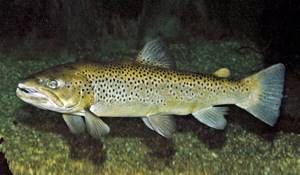
Photo: Trout fish
Brown trout inhabit very large areas. It can easily be found both directly in the seas and in rivers.
The largest habitat areas for brown trout are:
- Azov, Black Seas;
- Volga, Neva, Gulf of Finland;
- rivers of France, Greece, Italy;
- rivers of the Urals;
- Pskov, Tver, Kaliningrad, Orenburg regions.
The largest number of trout is observed in the Baltic waters. Thickets and shallows are the main places where trout accumulate. When catching this fish, the fishing rod must first be cast close to the shore. There is no need to swim further - most often it is concentrated here.
The favorite habitats of brown trout are mountainous areas or plain water bodies. The key factor is water purity. Even if there is a strong current there is no problem. The brown trout will simply come closer to the shore and find a secluded place to live.
This fish does not favor too warm water. The ideal temperature for it is 15-20 degrees. Even for spawning, the fish does not go into very warm waters, preferring clean, but slightly cool waters. The most interesting thing is that brown trout can live in different conditions - both in the river and in the sea.
The fish chooses those conditions that are most acceptable to it at the moment and which will contribute to the preservation of the population. Often, brown trout do not live in one place for more than 2-3 years. She changes her habitat, but after a year or two she can return to the same place where she lived before.
Now you know where the brown trout are found. Let's see what this fish eats.
What does brown trout eat?
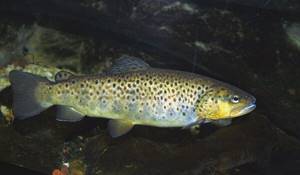
Photo: Brown trout in Karelia
Trout belongs to the category of predatory fish. Small newborn representatives of the breed feed on plankton and only when the fish become sexually mature do their diet diversify. By the way, large specimens of brown trout may well feed on mammals, which often swim across bodies of water. But this only applies to those cases when the fish is too hungry.
The rest of the time their diet consists of:
- frogs;
- small fish that are much smaller in size;
- various crustaceans;
- mollusks, worms and other invertebrates that inhabit the bottom layers of the reservoir;
- insect larvae that live near water;
- grasshoppers, butterflies and other insects that fall into a pond.
Although brown trout is essentially a predatory fish, if necessary (in the absence of a sufficient amount of food), it can also feed on plant foods. If we talk about catching brown trout, then it is quite possible to catch it with corn or bread.
At the same time, brown trout still prefer animal food, eating plant food only in exceptional cases. Often brown trout can attack small schools of fish living in the coastal zone. Brown trout also actively hunt in the thickets near the shore for crustaceans (they can even attack large individuals). Can actively hunt at any time of the year.
Features of character and lifestyle
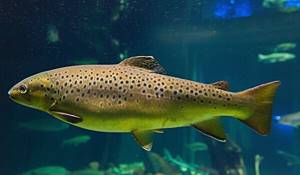
Photo: Brown trout in the lake
Trout should be classified as an anadromous or freshwater fish. In the sea, brown trout prefer to live closer to the shore, without swimming into particularly deep areas. He tries to avoid any long-distance migrations. Even if we talk about spawning, she tries to choose those places that are as close as possible to her usual habitat.
If we talk about life in rivers, trout prefer the upper reaches, but occasionally they can go further from the shore into rocky ground. Brown trout need a large amount of oxygen in the water for normal functioning. That is why she loves fast rivers and swift currents so much. Sometimes brown trout may not return to the sea at all, but continue to live in the river if conditions are favorable for this. We are talking about a sufficient number of shelters that are located near shallow water. This is necessary so that the fish can hunt normally. In the morning and evening, fish like to hunt in the river with very clear water - this is the favorite habitat of brown trout.
In some places (Luga and Narva Bays) small-sized trout can be found throughout the year. Typically, fish begin to enter the river closer to mid-spring and early summer. The fish movement becomes most intense in September and lasts right up to November. It takes 2-4 years before they migrate to the sea, after which after 1-2 years they return to the river again.
Brown trout are not schooling fish. She prefers to live alone. The same applies to migration and hunting. By the way, brown trout are very brave in hunting. Although she herself prefers solitude, she can still challenge and attack representatives of schooling fish.
Social structure and reproduction
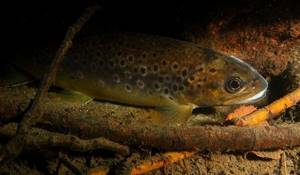
Photo: Brown trout in the water
Brown trout are not schooling fish. She prefers living and hunting alone. Although she prefers to go to spawning in large groups. But this is more likely due to the fact that the fish choose the same time for spawning. Unlike many other salmonids, brown trout can spawn several times during their life.
Almost all typical representatives of salmon spawn only once in their lives. Before this, they try to eat as little as possible and die soon after spawning. But brown trout behave completely differently. Her diet is in no way connected with spawning: she continues to eat all the time in the usual way, and soon after spawning she returns to her usual way of life.
Interesting fact: If the brown trout were unable to return to the sea for any reason, they can easily adapt to life in fresh water.
Brown trout can spawn at any time of the year. The only exception is winter. At one time, the female lays 4-5 thousand eggs. All of them are quite large - about 5 ml in diameter. The fish most often lays its eggs in coastal areas of water bodies, burying them in the sand. She can also spawn, choosing a secluded place under stones.
Brown trout choose river beds for spawning, entering there from their usual habitat - from the sea. After laying eggs, it immediately goes back to the sea. The male fertilizes the spawned eggs, but does not take further part in the life of the offspring. For example, if in some species of fish the males guard the eggs until the fry appear, then in the brown trout this is not the case.
Brown trout fry are relatively small - about 6 ml immediately after they hatch. From 2 to 7 years, the fry continues to live in the river where it was hatched. While the fry is growing, it feeds on larvae. But when it reaches comparative maturity (about 20 cm at that time), it moves to the sea and begins to feed on the fry of other fish or invertebrates there. The fish lives in the sea for about 4 years before reaching full maturity. In total, a female brown trout goes to spawn about 8-10 times in her entire life. The lifespan of fish is 18-20 years.
Interesting fact: When brown trout go to spawn, they have to form a kind of herd. This is necessary for the reason that among migratory fish there are significantly fewer males, while freshwater trout have an excess of males. So they have to unite during the spawning period.
Pars Today
One of the most valuable fish that lives in the waters of the Caspian Sea in northern Iran is the Caspian salmon (or Caspian trout - lat. Salmo trutta caspius).
This is one of the brightest representatives of bony fishes, which is of great value for fishing, especially in the southern (deep-water) part of the Caspian Sea. Unfortunately, today the population of this important fish is in danger of extinction.
Trout is a fish that belongs to the salmon family. Moreover, she is a typical representative of it. There are many subspecies of this fish, and each of them has its own distinctive characteristics. For example, some specimens do not exceed a weight of 2 kg, while others reach a weight of more than 20. Brown trout has very tasty meat rich in useful elements. Minimal fat content, a normal amount of calories per 100 grams of weight, as well as excellent digestibility - all this represents the main advantages of fish.
According to its habitat, brown trout is considered a very common fish. Anadromous and freshwater representatives usually live in the basins of large rivers with appropriate water. Caspian trout prefer the Caspian Sea, as its name suggests. Moreover, at the time when it goes to spawn, it can turn into freshwater. The mating season takes place on the Kura River. Another representative is salmon, which lives in the Azov and Black Seas. All sea or lake fish belonging to this species have a distinctive feature. It lies in the fact that trout, in fact, does not care what kind of water it is: salty or fresh. She can live everywhere. This has a positive effect on its widespread distribution.
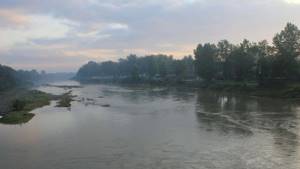
Sefidrud River, in northern Iran, one of the salmon spawning grounds
The appearance of representatives of the salmon family varies depending on the subspecies. Most typical specimens, such as Taimyr, anadromous or freshwater trout, have the characteristics described below. Mouth slanted downwards. If the individual is large in size, then it has a characteristic hook on the lower jaw. Small fin on the back. Powerful tail. Small adipose fin. Spots all over the body.
Sea and lake fish are similar in appearance, body structure and even taste. The only difference lies in the habitat itself, which they can change at their discretion. The specimens also vary in weight. The largest is the Caspian trout. Specimens weighing 10 and 20 kg are known. In general, the mass of the expected prey can be determined from its habitat. If the reservoir is small, then the size and weight will be small, and vice versa.
Brown trout is a fish that, for spawning, selects areas of water bodies where it is shallow and there are a lot of stones. This is due to the fact that small eggs hide under them or bury themselves in the sand if it is large. A distinctive feature of brown trout is that it continues to feed during spawning. Having released an average of 7-12 thousand eggs, the fish quietly engages in fishing for crayfish, herring, and so on. The size of the fry is 5-6 mm in diameter. A female can go to spawn no more than 10 times in her entire life. At first, the babies live in the place where spawning took place. After growing up, they follow the adults into the sea or lake.
Brown trout is a fish that can live 19-20 years. Anadromous and marine species have a shorter lifespan, unlike lake species. However, this time is enough for fishing; it is possible to enjoy adult meat without interfering with procreation. Lifestyle It is believed that all fish of the salmon family (the list of representatives is very large) are predators by nature. Many people find small crayfish in their stomach while cutting. There are also other fish. In general, brown trout are not fixated on their diet; they are ready to eat everything that comes their way. But there are other examples. There are two representatives of the breed in Lake Ohrid. The first, trout, reaches a weight of 10 kg and it feeds exclusively on meat products. The second specimen is a small silver fish. Its diet consists only of small crustaceans or plankton. Few people can tell by their appearance that they belong to the same breed.
Brown trout spend most of their lives in salt water. It swims to freshwater rivers to spawn. The fry grows there too. As an adult, it returns to the sea or salt water lake. Interesting facts about fish. As indicated, the largest representative is the Caspian trout. There is a recorded case in history when a fisherman managed to catch one weighing 51 kg. But today large specimens are not available, since fishing is observed wherever brown trout are found. Therefore, it simply does not have time to grow to such a large size.
Caspian salmon is somewhat similar to salmon. For a long time, the similarity with salmon forced taxonomists to consider Caspian salmon a subspecies of salmon. However, it was established that, based on the structural features of the embryo in the egg and the number of chromosomes, this is a greatly changed form of brown trout. Caspian salmon enters for spawning mainly in the rivers of the western shore of the Caspian Sea, most of it in the Kura, less in the Terek, Araks, Lenkoranka. It enters the Volga in single specimens; its capture by poachers has been reported several times, usually in winter. But it was not always so. There are indications in the archives that in the 17th century. Salmon was caught in commercial quantities near Kazan and entered the Kama, Belaya and Oka rivers. The high taste of the meat of this fish led to its overfishing, and a change in the nature of the Volga flow caused the complete disappearance of the Volga herd. This salmon was also in the Aral Sea, and went up to the Syr Darya to spawn, but due to the fact that only a small salted puddle remained from the Aral Sea, the Aral salmon disappeared along with other fish that once inhabited this rich reservoir.
Caspian salmon farming
Now the Caspian salmon is classified as an endangered species and is listed in the Red Book of the Russian Federation, Iran and Kazakhstan. Work on artificial reproduction is practically carried out in all Caspian countries, which gives hope that this unique fish will not disappear completely.
Natural enemies of brown trout
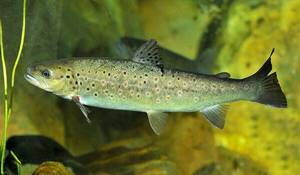
Photo: Trout fish
The main enemies of brown trout have always been and remain poachers. They are capable of destroying both adult individuals and the eggs themselves. Most often, they hunt individuals directly during the spawning period, thereby destroying both the adult trout itself and the unborn offspring. But if protection from poaching is possible at least partially at the state level, it is almost impossible to protect the fish population from natural enemies.
The main natural enemies of brown trout include:
- burbot, grayling and even other young representatives of the salmon family (who have not yet reached sexual maturity and continue to live in spawning areas) hunt newborn fry and eggs;
- fish that actively hunt on the water. They can catch trout even in the open sea if it comes close to the surface of the water. Particularly dangerous are those species of birds that are capable of diving;
- beavers. Although these animals themselves are rare, they are still capable of causing a lot of harm when hunting for rare fish;
- seals and polar bears love to feast on such fish, so they are also direct enemies of brown trout. They are able to catch fish directly in the water. Since they are very dexterous, swim quickly, including under water, they can cause a lot of harm to the brown trout population.
On average, about 1 in 10 individuals survive the first year after birth. Then their mortality gradually decreases and after the first year of life, about 1 out of 2 fish survives. But if we talk about the average population, then no more than 2-3 fish out of 100 survive to sexual maturity and spawning.
Brown trout meat
The salmon breed in question is in no way inferior to animal meat in terms of taste and culinary qualities. Moreover, when prepared correctly, it is even better. First of all, this lies in the fact that meat is easily digestible, even by small children.
Trout is not an oily fish, but very tender. This is due to the fact that there are layers of fat on the meat in its carcass. But they are located unevenly, so some parts of the animal can only be cooked in one way, while others offer room for culinary imagination. Also, the amount of fat depends on the time of fishing; during spawning, for example, the fish gets fatter, and by the end of it it becomes thinner.
Population and species status
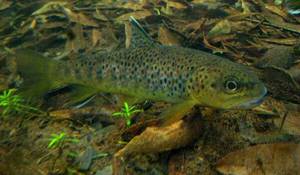
Photo: What does brown trout look like?
It is impossible to accurately estimate the exact population of brown trout. The reason is that fish inhabit large areas. The population has many different subspecies. Therefore, it is impossible to say reliably how many brown trout currently live on the planet. In addition, fish also live on private property, on farms.
Brown trout, according to the generally accepted division, belongs to a category of fish whose numbers are rapidly declining. This is due to the fact that it is an object of active fishing. That is why active measures are currently being taken at the state level to protect the species.
A compromise solution is specially designed farms where fish are purposefully grown for subsequent catching and use as food. Also, in order to preserve the species, they often prefer to release fish into natural conditions for subsequent adaptation and reproduction. Unfortunately, this has not yet given the desired result.
Trout, like other representatives of the salmon family, has very tasty meat, and therefore is subject to active fishing, including by poachers. The number of brown trout is declining mainly for the reason that much more fish are caught at the time of spawning, when they are especially exposed and vulnerable. Because of this, the number is declining precisely due to the lack of proper offspring.
Interesting fact: In the 30s of the last century, the annual catch of trout exceeded 600 tons, while now it barely reaches 5 tons.
Trout fishing
For most hunters, fish is of great value - after all, it is a predator. Before fishing, the habits of the fish are also taken into account, because when searching for food, brown trout go to shallow water.
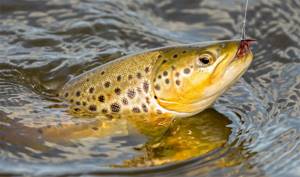
Trout fishing
For fishing, you should choose float gear up to 5 m in order to comfortably move along the shore with large thickets. A worm or maggot is suitable as bait.
Advice! During spawning, trout are found at any depth.
When fishing with a spinning rod, you should choose gear for a specific time of year. In summer, fish live near the surface, so it is better to choose a spoon. Wobblers are recommended in autumn and spring. The best time of day is morning.
To learn more:
Taimen: a valuable fish of the salmon family
It is not wise to catch fish after spawning because they lose weight.
